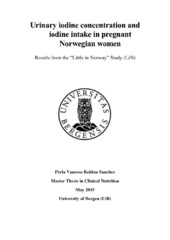Urinary iodine concentration and iodine intake in pregnant Norwegian women. Results from the “Little in Norway” Study (LiN)
Master thesis
Permanent lenke
https://hdl.handle.net/1956/10179Utgivelsesdato
2015-05-15Metadata
Vis full innførselSamlinger
Sammendrag
Background Iodine is an essential nutrient for the synthesis of thyroid hormones. Inadequate iodine intake is especially critical during pregnancy, lactation and early childhood. Iodine deficiency early in life impairs the developing brain. Iodine deficiency is defined as a median urine concentration less than 150 µg/ L in pregnant women. Seafood, milk-and dairy products, eggs and iodine-containing supplements are dietary iodine sources in Norway. Recently studies indicate that iodine status in pregnant women could be suboptimal. Aims The aims of the study were: [1] to determinate the iodine status of the pregnant women based on urinary iodine concentration from a spot urine sample using the World Health Organization (WHO). [2] to estimate the iodine intake from selected food groups and iodine- containing supplements using a food frequency questionnaire (FFQ) to evaluate whether or not it is in accordance with the Norwegian recommendation. [3] to assess influence of some factors (e.g. weeks of gestation, timing and season of spot urine collection) on the urinary iodine concentration (UIC) during pregnancy. Methods A total of 1036 pregnant women included in the study were recruited within the period 2011 - 2012 from nine well-baby clinics across the Norwegian Health Regions. A spot urine sample (to measure UIC) was collected from 1008 participants at the first meeting in the clinic. UIC were determined using inductively couple plasma spectrometry (ICP-MS). A self- administrative, semi quantitative FFQ (to estimate iodine intake) were filled in at home from 833 participants. Results Median UIC was 82 µg/ L and 80% of the urine samples were below 150 µg/ L. Data from the FFQ revealed that 30% ate seafood 2 - 3 times per week at dinner, 68% ate milk-and dairy products 2 - 3 times per day and 39% ate egg 2 - 3 times per week. Iodine-containing supplements were reported by 14% of the women. The total median iodine intake from foods and supplements was 153 µg/ day. Intake of milk-and dairy products and gestational age correlated significantly with median UIC. Conclusions Findings in the present study from median UIC classify the pregnant women as iodine deficient. Estimated dietary iodine intake also shows inadequate iodine intake among the women. In conclusion, this study shows that the diet of the pregnant women does not secure a sufficient iodine intake and one strategy to increase the iodine intake could be to increase the seafood intake.
